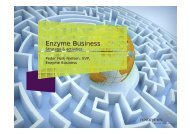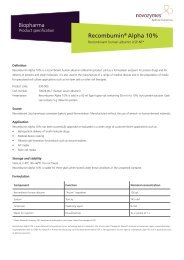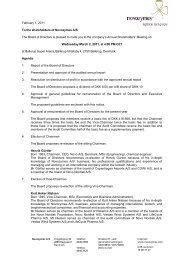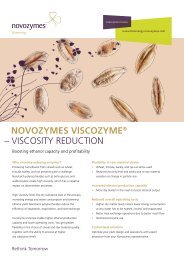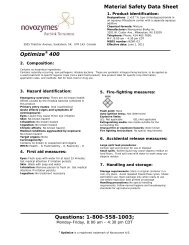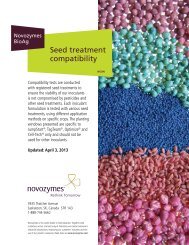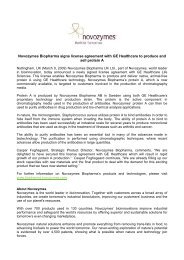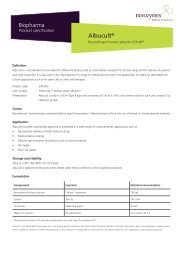Novozymes Cellic[®] CTec3 - Secure your plant's lowest total cost
Novozymes Cellic[®] CTec3 - Secure your plant's lowest total cost
Novozymes Cellic[®] CTec3 - Secure your plant's lowest total cost
Create successful ePaper yourself
Turn your PDF publications into a flip-book with our unique Google optimized e-Paper software.
Fig. 2. Enzyme dose response for <strong>Cellic</strong> ® <strong>CTec3</strong> after 5 days of enzyme hydrolysis at 50°C and pH 5.0 of anunwashed sample of dilute acid-pretreated corn stover (18% <strong>total</strong> solids loading). If 80% conversion is requiredthen the recommended dosage for this feedstock under the hydrolysis conditions mentioned above would be~3% w/w (30g-<strong>Cellic</strong> <strong>CTec3</strong>/kg-cellulose).<strong>Cellic</strong> <strong>CTec3</strong> is a highly efficient cellulase and hemicellulase complex that works on a varietyof substrates, including acid, auto-hydrolyzed, and alkaline pretreated substrates.Frequently, only <strong>Cellic</strong> <strong>CTec3</strong> will be needed. However, if the pretreated feedstock of interestcontains an appreciable amount of hemicellulose, it is advisable to combine <strong>Cellic</strong> <strong>CTec3</strong>with other lignocellulytic enzymes, such as our latest <strong>Cellic</strong> HTec product, to further boostoverall conversion yields and potentially reduce the severity of <strong>your</strong> pretreatment. Theenzyme type and dosage recommendation will depend on product, feedstock type,pretreatment technology, and processing conditions. For further technical advice about <strong>your</strong>specific substrate and targets, please contact <strong>your</strong> technical representative from <strong>Novozymes</strong>.Considerations for enzyme applicationHistorically, cellulosic enzymes were significantly affected by feedback inhibition resultingfrom glucose production, which led to ineffective conversion. Later generations of enzymes,including <strong>Cellic</strong> <strong>CTec3</strong>, were developed to eliminate this effect on the enzyme complex.With the introduction of <strong>Cellic</strong> <strong>CTec3</strong>, there are more options available for considerationwhen selecting optimal process layout and targeting <strong>cost</strong>-efficient cellulose conversion.These include simultaneous saccharification and fermentation (SSF), separate hydrolysis andfermentation (SHF), and a modified version of these referred to as hybrid hydrolysis andfermentation (HHF). The hybrid HHF process can also be described as viscosity reduction andpre-saccharification followed by SSF for ethanol production, and this setup can beconfigured in relation to overall process layout and conversion targets. The impact ofhydrolysis and fermentation conditions using <strong>Cellic</strong> <strong>CTec3</strong> on pretreated corn stover isillustrated in Figure 2 (enzyme and fermentation kinetics and final ethanol yields willdepend on pretreated substrate, fermentation organism, and process configuration).3/6
Fig. 3. Ethanol yield under varying hydrolysis conditions using <strong>Cellic</strong> ® <strong>CTec3</strong> at pH 5.0 and 50 °C on unwasheddilute acid-pretreated corn stover at 18% <strong>total</strong> solids loading. The yeast was pitched at different times, asindicated by initiation of ethanol production. The ethanol yield will vary depending on the substrate, enzymedosing, yeast pitch, and hydrolysis configuration. In this example, an SSF configuration does not achieve thesame yields as the options that include a dedicated hydrolysis step prior to fermentation. The process timeavailable for hydrolysis and fermentation will dictate the options available.Temperature and pH guidelinesOptimal performance of <strong>Cellic</strong> <strong>CTec3</strong> occurs at a temperature range of 50-55 °C and at pH4.75-5.25, as illustrated in figures 3 and 4. The optimal conditions can vary with specificpretreated substrates and process conditions (e.g. solids content and hydrolysis time);however, our recommendations are to conduct hydrolysis within the range of conditionsspecified above. Please consult with <strong>your</strong> <strong>Novozymes</strong> representative for further guidance onidentifying optimal conditions for <strong>your</strong> specific substrate and process.We recommend that you monitor and control pH and temperature within the rangessuggested above in that stage of <strong>your</strong> process where enzymes are applied, as majordeviations could have an impact on hydrolysis kinetics and final conversion yields. Complexenzyme systems may be irreversibly damaged by high temperature and strong acidic oralkaline conditions. Due to this fact, we strongly recommend that you adjust pH andtemperature to proper operational conditions prior to enzyme addition in order to ensureoptimal conversion of <strong>your</strong> pretreated substrate.<strong>Cellic</strong> <strong>CTec3</strong> temperature profileRelative performanceFig. 4. Relative product performance of <strong>Cellic</strong> ® <strong>CTec3</strong> with respect to reaction temperature for unwashed acidpretreatedcorn stover (PCS) at 18%TS for 3-5 days; pH 5 for all data points 4/6
<strong>Cellic</strong> <strong>CTec3</strong> pH profileRelative performanceFig. 5. Relative product performance of <strong>Cellic</strong> ® <strong>CTec3</strong> with respect to pH of reaction for unwashed acidpretreatedcorn stover (PCS) at 18%TS for 3-5 days; temperature 52.5 °C for all data pointsEnzyme activity and formulationBiomass substrates are composed of lignin and a number of mutually entangled andchemically bonded carbohydrate polymers that require multiple enzymes working togethersynergistically for complete hydrolysis. For this reason, the performance of a complex multicomponentenzyme product such as <strong>Cellic</strong> <strong>CTec3</strong> cannot be evaluated based on the activityof a single enzyme or using single polymer substrate such as filter paper, Avicel orcarboxymethyl cellulose (CMC). Therefore, <strong>Novozymes</strong> has developed a performance activityassay based on acid-pretreated corn stover for our internal quality control, so we can deliverhigh performance products to our customers in a consistent manner. The method uses afluorescence enhancement marker and measures the extent of cellulose hydrolysis relative toa standard enzyme concentration for quantification of Biomass Hydrolysis Units – BHU(2).<strong>Cellic</strong> <strong>CTec3</strong> contains a minimum of 1,700 BHU(2)/g-product. <strong>Cellic</strong> <strong>CTec3</strong> contains chemicalformulations for improved storage stability, including glucose and/or sucrose. Thesecompounds may affect the interpretation of hydrolysis data analysis when <strong>Cellic</strong> <strong>CTec3</strong> isdosed at high levels.5/6
Safety, handling, and storageFor best product performance, <strong>Cellic</strong> <strong>CTec3</strong> should be stored at cool temperatures in closedcontainers protected from sunlight. The product has been formulated for optimal storagestability; however, enzymes gradually lose their activity over time. The recommendedstorage conditions are 0-25 °C (32-77 °F). Prolonged storage time and/or adverse conditionssuch as higher temperature may lead to a higher dosage requirement.Safety, handling, and storage guidelines are provided with all products. Please contact <strong>your</strong><strong>Novozymes</strong> representative for this information.Additional informationOur committed expert technical and commercial teams will be pleased to help youcommercialize cellulosic ethanol production while always keeping <strong>your</strong> specific goals inmind. For further information, please contact <strong>your</strong> <strong>Novozymes</strong> representative or visitwww.bioenergy.novozymes.com.Join us on the path to commercializing cellulosic ethanol!<strong>Novozymes</strong> A/STel: +45 4446 0000Fax: +45 4446 9999Krogshoejvej 362880 BagsvaerdDenmarkbioenergy@novozymes.com<strong>Novozymes</strong> is the world leader in bioinnovation. Together withcustomers across a broad array of industries we create tomorrow’sindustrial biosolutions, improving our customers' business, and the useof our planet's resources. Read more at www.novozymes.com.<strong>Novozymes</strong> delivers advanced bioinnovation solutions to the bioenergyindustry by setting new standards in performance and viability; helpingthe world realize the promise of renewable energy.<strong>Novozymes</strong> A/S · Luna No. 2012-01394-01Laws, regulations, and/or third-party rights may prevent customers from importing, using, processing, and/or reselling the products described herein in a givenmanner. Without separate, written agreement between the customer and <strong>Novozymes</strong> to such effect, information provided in this document “AS IS” is of goodfaith and does not constitute a representation or warranty of any kind and is subject to change without further notice.6/6


![Novozymes Cellic[®] CTec3 - Secure your plant's lowest total cost](https://img.yumpu.com/50573332/1/500x640/novozymes-cellicar-ctec3-secure-your-plants-lowest-total-cost.jpg)

